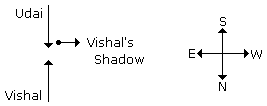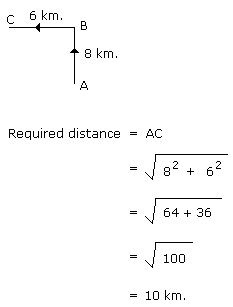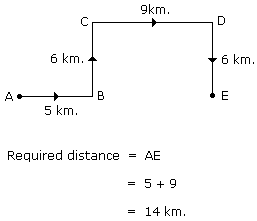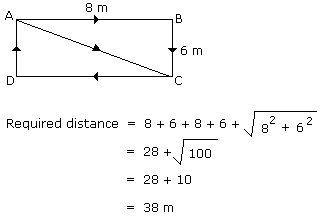All Exams >
CA Foundation >
Quantitative Aptitude for CA Foundation >
All Questions
All questions of Chapter 10: Direction Tests for CA Foundation Exam
A man walks 2 km towards North. Then he turns to East and walks 10 km. After this he turns to North and walks 3 km. Again he turns towards East and walks 2 km. How far is he from the starting point?- a)10 km
- b)13 km
- c)15 km
- d)None of these
Correct answer is option 'B'. Can you explain this answer?
A man walks 2 km towards North. Then he turns to East and walks 10 km. After this he turns to North and walks 3 km. Again he turns towards East and walks 2 km. How far is he from the starting point?
a)
10 km
b)
13 km
c)
15 km
d)
None of these

|
Madhavan Saha answered |
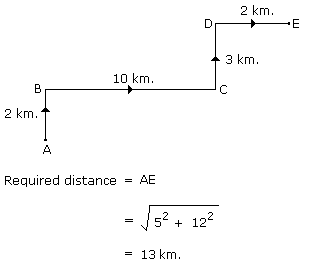
Directions to Solve Each of the following questions is based on the following information: - 8-trees → mango, guava, papaya, pomegranate, lemon, banana, raspberry and apple are in two rows 4 in each facing North and South.
- Lemon is between mango and apple but just opposite to guava.
- Banana is at one end of a line and is just next in the right of guava or either banana tree is just after guava tree.
- Raspberry tree which at one end of a line, is just diagonally opposite to mango tree.
Question - Which tree is just opposite to banana tree?- a)Mango
- b)Pomegranate
- c)Papaya
- d)Data is inadequate
Correct answer is option 'A'. Can you explain this answer?
Directions to Solve
Each of the following questions is based on the following information:
Question - - 8-trees → mango, guava, papaya, pomegranate, lemon, banana, raspberry and apple are in two rows 4 in each facing North and South.
- Lemon is between mango and apple but just opposite to guava.
- Banana is at one end of a line and is just next in the right of guava or either banana tree is just after guava tree.
- Raspberry tree which at one end of a line, is just diagonally opposite to mango tree.
Which tree is just opposite to banana tree?
a)
Mango
b)
Pomegranate
c)
Papaya
d)
Data is inadequate

|
Nilanjan Kumar answered |
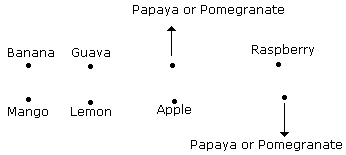
After walking 6 km, I turned to the right and then walked 2 km. After then I turned to the left and walked 10 km. In the end, I was moving towards the North. From which direction did I start my journey?
- a)North
- b)South
- c)East
- d)West
Correct answer is option 'B'. Can you explain this answer?
After walking 6 km, I turned to the right and then walked 2 km. After then I turned to the left and walked 10 km. In the end, I was moving towards the North. From which direction did I start my journey?
a)
North
b)
South
c)
East
d)
West

|
Maheshwar Chakraborty answered |
Clearly, the route is as shown in the adjoining diagram. Thus, I started the journey from the South and moved northwards
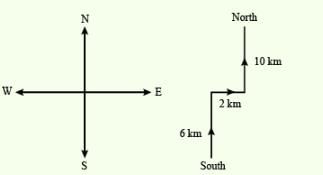
One morning after sunrise, Vimal started to walk. During this walking he met Stephen who was coming from opposite direction. Vimal watch that the shadow of Stephen to the right of him (Vimal). To Which direction Vimal was facing?- a)East
- b)West
- c)South
- d)Data inadequate
Correct answer is option 'C'. Can you explain this answer?
One morning after sunrise, Vimal started to walk. During this walking he met Stephen who was coming from opposite direction. Vimal watch that the shadow of Stephen to the right of him (Vimal). To Which direction Vimal was facing?
a)
East
b)
West
c)
South
d)
Data inadequate

|
Uday Nambiar answered |
Sun rises in the east. So the shadow of a man will always falls towards the west. Since the shadow of Stephen is to the right of Vimal. Hence Vimal is facing towards South.
Directions to Solve Each of the following questions is based on the following information: - 8-trees → mango, guava, papaya, pomegranate, lemon, banana, raspberry and apple are in two rows 4 in each facing North and South.
- Lemon is between mango and apple but just opposite to guava.
- Banana is at one end of a line and is just next in the right of guava or either banana tree is just after guava tree.
- Raspberry tree which at one end of a line, is just diagonally opposite to mango tree.
Question - Which of the following statements is definitely true?- a)Papaya tree is just near to apple tree.
- b)Apple tree is just next to lemon tree.
- c)Raspberry tree is either left to Pomegranate or after.
- d)Pomegranate tree is diagonally opposite to banana tree.
Correct answer is option 'B'. Can you explain this answer?
Directions to Solve
Each of the following questions is based on the following information:
Question - - 8-trees → mango, guava, papaya, pomegranate, lemon, banana, raspberry and apple are in two rows 4 in each facing North and South.
- Lemon is between mango and apple but just opposite to guava.
- Banana is at one end of a line and is just next in the right of guava or either banana tree is just after guava tree.
- Raspberry tree which at one end of a line, is just diagonally opposite to mango tree.
Which of the following statements is definitely true?
a)
Papaya tree is just near to apple tree.
b)
Apple tree is just next to lemon tree.
c)
Raspberry tree is either left to Pomegranate or after.
d)
Pomegranate tree is diagonally opposite to banana tree.

|
Maulik Unni answered |
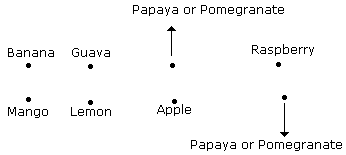
Two cars start from the opposite places of a main road, 150 km apart. First car runs for 25 km and takes a right turn and then runs 15 km. It then turns left and then runs for another 25 km and then takes the direction back to reach the main road. In the mean time, due to minor break down the other car has run only 35 km along the main road. What would be the distance between two cars at this point?- a)65 km
- b)75 km
- c)80 km
- d)85 km
Correct answer is option 'A'. Can you explain this answer?
Two cars start from the opposite places of a main road, 150 km apart. First car runs for 25 km and takes a right turn and then runs 15 km. It then turns left and then runs for another 25 km and then takes the direction back to reach the main road. In the mean time, due to minor break down the other car has run only 35 km along the main road. What would be the distance between two cars at this point?
a)
65 km
b)
75 km
c)
80 km
d)
85 km

|
Janhavi Nambiar answered |
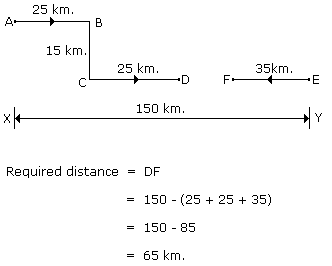
Directions to Solve Dev, Kumar, Nilesh, Ankur and Pintu are standing facing to the North in a playground such as given below:- Kumar is at 40 m to the right of Ankur.
- Dev is are 60 m in the south of Kumar.
- Nilesh is at a distance of 25 m in the west of Ankur.
- Pintu is at a distance of 90 m in the North of Dev.
Question - Which one is in the North-East of the person who is to the left of Kumar?- a)Dev
- b)Nilesh
- c)Ankur
- d)Pintu
Correct answer is option 'D'. Can you explain this answer?
Directions to Solve
Dev, Kumar, Nilesh, Ankur and Pintu are standing facing to the North in a playground such as given below:
Question - - Kumar is at 40 m to the right of Ankur.
- Dev is are 60 m in the south of Kumar.
- Nilesh is at a distance of 25 m in the west of Ankur.
- Pintu is at a distance of 90 m in the North of Dev.
Which one is in the North-East of the person who is to the left of Kumar?
a)
Dev
b)
Nilesh
c)
Ankur
d)
Pintu

|
Arnav Rane answered |
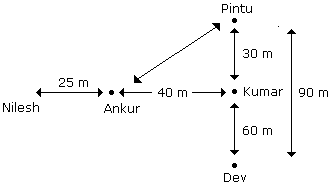
Ankur is in the left of Kumar. Hence Pintu is in North-East of Ankur.
Hemant in order to go to university started from his house in the east and came to a crossing. The road to the left ends in a theatre, straight ahead is the hospital. In which direction is the university?- a)North
- b)South
- c)East
- d)West
Correct answer is option 'A'. Can you explain this answer?
Hemant in order to go to university started from his house in the east and came to a crossing. The road to the left ends in a theatre, straight ahead is the hospital. In which direction is the university?
a)
North
b)
South
c)
East
d)
West

|
Mainak Malik answered |
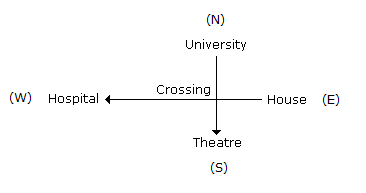
Therefore university is in North.
Reena walked from A to B in the East 10 feet. Then she turned to the right and walked 3 feet. Again she turned to the right and walked 14 feet. How far is she from A?- a)4 feet
- b)5 feet
- c)24 feet
- d)27 feet
Correct answer is option 'B'. Can you explain this answer?
Reena walked from A to B in the East 10 feet. Then she turned to the right and walked 3 feet. Again she turned to the right and walked 14 feet. How far is she from A?
a)
4 feet
b)
5 feet
c)
24 feet
d)
27 feet

|
Jatin Nambiar answered |
Steps to solve the problem:
1. Initial Movement:
- Reena walked East from point A for 10 feet.
- This means she moved 10 feet to the right.
2. First Turn:
- Reena turned to the right and walked 3 feet.
- This forms a right-angled triangle with 10 feet as the base and 3 feet as the perpendicular.
3. Calculating the Hypotenuse:
- Using the Pythagorean theorem (a^2 + b^2 = c^2), where a = 10 feet, b = 3 feet.
- Calculating the hypotenuse, we get c = √(10^2 + 3^2) = √(100 + 9) = √109 ≈ 10.44 feet.
4. Second Turn:
- Reena turned to the right again and walked 14 feet.
- This creates a new right-angled triangle with the previous hypotenuse as the base and 14 feet as the perpendicular.
5. Calculating the Final Distance:
- Using the Pythagorean theorem again, where a = 10.44 feet (previous hypotenuse), b = 14 feet.
- Calculating the final distance, we get c = √(10.44^2 + 14^2) = √(108.9 + 196) = √304.9 ≈ 17.47 feet.
Therefore, Reena is approximately 17.47 feet away from point A after walking 10 feet East, then 3 feet right, and finally 14 feet right again. So, the closest option is 5 feet (option B).
1. Initial Movement:
- Reena walked East from point A for 10 feet.
- This means she moved 10 feet to the right.
2. First Turn:
- Reena turned to the right and walked 3 feet.
- This forms a right-angled triangle with 10 feet as the base and 3 feet as the perpendicular.
3. Calculating the Hypotenuse:
- Using the Pythagorean theorem (a^2 + b^2 = c^2), where a = 10 feet, b = 3 feet.
- Calculating the hypotenuse, we get c = √(10^2 + 3^2) = √(100 + 9) = √109 ≈ 10.44 feet.
4. Second Turn:
- Reena turned to the right again and walked 14 feet.
- This creates a new right-angled triangle with the previous hypotenuse as the base and 14 feet as the perpendicular.
5. Calculating the Final Distance:
- Using the Pythagorean theorem again, where a = 10.44 feet (previous hypotenuse), b = 14 feet.
- Calculating the final distance, we get c = √(10.44^2 + 14^2) = √(108.9 + 196) = √304.9 ≈ 17.47 feet.
Therefore, Reena is approximately 17.47 feet away from point A after walking 10 feet East, then 3 feet right, and finally 14 feet right again. So, the closest option is 5 feet (option B).
Four friends A, B, C and D live in a same locality. The house of B is in the east of A's house but in the north of C's house. The house of C is in the west of D's house. D's house is in which direction of A's house?- a)South-East
- b)North-East
- c)East
- d)Data is inadequate
Correct answer is option 'A'. Can you explain this answer?
Four friends A, B, C and D live in a same locality. The house of B is in the east of A's house but in the north of C's house. The house of C is in the west of D's house. D's house is in which direction of A's house?
a)
South-East
b)
North-East
c)
East
d)
Data is inadequate

|
Aravind Pillai answered |
Explanation:
Given Information:
- B's house is in the east of A's house but in the north of C's house.
- C's house is in the west of D's house.
Analysis:
- A -> B -> C -> D (clockwise direction)
- B's house is in the east of A's house and in the north of C's house, which means C's house is to the south of B's house.
- C's house is in the west of D's house, which means D's house is to the east of C's house.
Conclusion:
- Based on the given information, the direction of D's house with respect to A's house would be South-East.
- Therefore, the correct answer is option A) South-East.
Given Information:
- B's house is in the east of A's house but in the north of C's house.
- C's house is in the west of D's house.
Analysis:
- A -> B -> C -> D (clockwise direction)
- B's house is in the east of A's house and in the north of C's house, which means C's house is to the south of B's house.
- C's house is in the west of D's house, which means D's house is to the east of C's house.
Conclusion:
- Based on the given information, the direction of D's house with respect to A's house would be South-East.
- Therefore, the correct answer is option A) South-East.
One morning sujata started to walk towards the Sun. After covering some distance she turned to right then again to the right and after covering some distance she again turns to the right. Now in which direction is she facing?- a)North
- b)South
- c)North-East
- d)South-West
Correct answer is option 'A'. Can you explain this answer?
One morning sujata started to walk towards the Sun. After covering some distance she turned to right then again to the right and after covering some distance she again turns to the right. Now in which direction is she facing?
a)
North
b)
South
c)
North-East
d)
South-West

|
Juhi Dasgupta answered |
Answer:
The direction she is facing is North.
Explanation:
To explain the answer, we can break the given information into the following steps:
Step 1: Sujata started to walk towards the Sun.
This means that Sujata was facing East at the beginning of her walk.
Step 2: After covering some distance, she turned to the right.
This indicates that Sujata made a 90-degree turn to her right. So, now she is facing South.
Step 3: Again, after covering some distance, she turned to the right.
This indicates that Sujata made another 90-degree turn to her right. So, now she is facing West.
Step 4: Once again, after covering some distance, she turned to the right.
This indicates that Sujata made another 90-degree turn to her right. So, now she is facing North.
Thus, we can conclude that Sujata is facing North after making three right turns from her initial direction of facing East. Hence, the correct answer is option 'A' - North.
The direction she is facing is North.
Explanation:
To explain the answer, we can break the given information into the following steps:
Step 1: Sujata started to walk towards the Sun.
This means that Sujata was facing East at the beginning of her walk.
Step 2: After covering some distance, she turned to the right.
This indicates that Sujata made a 90-degree turn to her right. So, now she is facing South.
Step 3: Again, after covering some distance, she turned to the right.
This indicates that Sujata made another 90-degree turn to her right. So, now she is facing West.
Step 4: Once again, after covering some distance, she turned to the right.
This indicates that Sujata made another 90-degree turn to her right. So, now she is facing North.
Thus, we can conclude that Sujata is facing North after making three right turns from her initial direction of facing East. Hence, the correct answer is option 'A' - North.
P started from his house towards west. After walking a distance of 25 m. He turned to the right and walked 10 m. He then again turned to the right and walked 15 m. After this he is to turn right at 135o and to cover 30 m. In which direction should he go?- a)West
- b)South
- c)South-West
- d)South-East
Correct answer is option 'C'. Can you explain this answer?
P started from his house towards west. After walking a distance of 25 m. He turned to the right and walked 10 m. He then again turned to the right and walked 15 m. After this he is to turn right at 135o and to cover 30 m. In which direction should he go?
a)
West
b)
South
c)
South-West
d)
South-East

|
Debolina Tiwari answered |
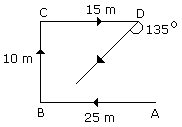
Hence he should go in the South-West direction.
Rohit walked 25 m towards south. Then he turned to his left and walked 20 m. He then turned to his left and walked 25 m. He again turned to his right and walked 15 m. At what distance is he from the starting point and in which direction?
- a)35 m East
- b)35 m North
- c)30 m West
- d)45 m East
Correct answer is option 'A'. Can you explain this answer?
Rohit walked 25 m towards south. Then he turned to his left and walked 20 m. He then turned to his left and walked 25 m. He again turned to his right and walked 15 m. At what distance is he from the starting point and in which direction?
a)
35 m East
b)
35 m North
c)
30 m West
d)
45 m East

|
Alok Kapoor answered |
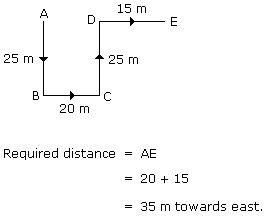
One morning after sunrise, Suresh was standing facing a pole. The shadow of the pole fell exactly to his right. To which direction was he facing?- a)East
- b)South
- c)West
- d)Data is inadequate
Correct answer is option 'B'. Can you explain this answer?
One morning after sunrise, Suresh was standing facing a pole. The shadow of the pole fell exactly to his right. To which direction was he facing?
a)
East
b)
South
c)
West
d)
Data is inadequate

|
Aravind Pillai answered |
Explanation:
To determine the direction in which Suresh was facing, we need to analyze the position of the shadow in relation to the pole and Suresh himself.
1. Position of the shadow:
The shadow fell exactly to Suresh's right. This means that the pole must be located to the east of Suresh. In the northern hemisphere, shadows move in the opposite direction of the sun. So, if the shadow is to the right of Suresh, it indicates that the sun is in the west.
2. Sun's position:
Since the sun rises in the east, if the pole casts a shadow to the right of Suresh, it implies that the sun is already in the west. This means that Suresh is facing towards the west.
3. Direction faced by Suresh:
If Suresh is facing towards the west, the opposite direction he is facing would be the east.
Therefore, based on the given information, Suresh is facing towards the east.
To determine the direction in which Suresh was facing, we need to analyze the position of the shadow in relation to the pole and Suresh himself.
1. Position of the shadow:
The shadow fell exactly to Suresh's right. This means that the pole must be located to the east of Suresh. In the northern hemisphere, shadows move in the opposite direction of the sun. So, if the shadow is to the right of Suresh, it indicates that the sun is in the west.
2. Sun's position:
Since the sun rises in the east, if the pole casts a shadow to the right of Suresh, it implies that the sun is already in the west. This means that Suresh is facing towards the west.
3. Direction faced by Suresh:
If Suresh is facing towards the west, the opposite direction he is facing would be the east.
Therefore, based on the given information, Suresh is facing towards the east.
If A x B means A is to the south of B; A + B means A is to the north of B; A % B means A is to the east of B; A - B means A is to the west of B; then in P % Q + R - S, S is in which direction with respect to Q?- a)South-West
- b)South-East
- c)North-East
- d)North-West
Correct answer is option 'B'. Can you explain this answer?
If A x B means A is to the south of B; A + B means A is to the north of B; A % B means A is to the east of B; A - B means A is to the west of B; then in P % Q + R - S, S is in which direction with respect to Q?
a)
South-West
b)
South-East
c)
North-East
d)
North-West

|
Abhishek Kumar answered |
According to P % Q + R - S

S is in the South-East of Q.
A boy rode his bicycle Northward, then turned left and rode 1 km and again turned left and rode 2 km. He found himself 1 km west of his starting point. How far did he ride northward initially?- a)1 km
- b)2 km
- c)3 km
- d)5 km
Correct answer is option 'B'. Can you explain this answer?
A boy rode his bicycle Northward, then turned left and rode 1 km and again turned left and rode 2 km. He found himself 1 km west of his starting point. How far did he ride northward initially?
a)
1 km
b)
2 km
c)
3 km
d)
5 km

|
Debolina Roy answered |

The boy rode 2 km. Northward.
Rahul put his timepiece on the table in such a way that at 6 P.M. hour hand points to North. In which direction the minute hand will point at 9.15 P.M. ?- a)South-East
- b)South
- c)North
- d)West
Correct answer is option 'D'. Can you explain this answer?
Rahul put his timepiece on the table in such a way that at 6 P.M. hour hand points to North. In which direction the minute hand will point at 9.15 P.M. ?
a)
South-East
b)
South
c)
North
d)
West

|
Janhavi Mishra answered |
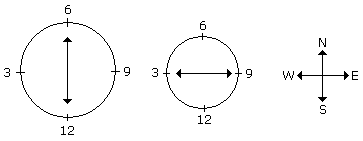
At 9.15 P.M., the minute hand will point towards west.
Starting from the point X, Jayant walked 15 m towards west. He turned left and walked 20 m. He then turned left and walked 15 m. After this he turned to his right and walked 12 m. How far and in which directions is now Jayant from X?- a)32 m, South
- b)47 m, East
- c)42 m, North
- d)27 m, South
Correct answer is option 'A'. Can you explain this answer?
Starting from the point X, Jayant walked 15 m towards west. He turned left and walked 20 m. He then turned left and walked 15 m. After this he turned to his right and walked 12 m. How far and in which directions is now Jayant from X?
a)
32 m, South
b)
47 m, East
c)
42 m, North
d)
27 m, South

|
Sahil Kumar answered |
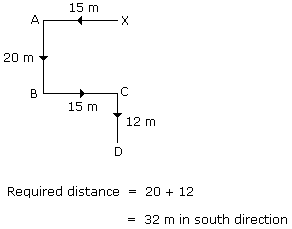
Directions to Solve Each of the following questions is based on the following information:- Six flats on a floor in two rows facing North and South are allotted to P, Q, R, S, T and U.
- Q gets a North facing flat and is not next to S.
- S and U get diagonally opposite flats.
- R next to U, gets a south facing flat and T gets North facing flat.
Question - If the flats of P and T are interchanged then whose flat will be next to that of U?- a)P
- b)Q
- c)R
- d)T
Correct answer is option 'C'. Can you explain this answer?
Directions to Solve
Each of the following questions is based on the following information:
Question - - Six flats on a floor in two rows facing North and South are allotted to P, Q, R, S, T and U.
- Q gets a North facing flat and is not next to S.
- S and U get diagonally opposite flats.
- R next to U, gets a south facing flat and T gets North facing flat.
If the flats of P and T are interchanged then whose flat will be next to that of U?
a)
P
b)
Q
c)
R
d)
T

|
Sravya Deshpande answered |
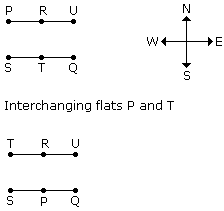
Hence flat R will be next to U.
A child went 90 m in the East to look for his father, then he turned right and went 20 m. After this he turned right and after going 30 m he reached to his uncle's house. His father was not there. From there he went 100 m to his north and met his father. How far did he meet his father from the starting point?- a)80 m
- b)100 m
- c)140 m
- d)260 m
Correct answer is option 'B'. Can you explain this answer?
A child went 90 m in the East to look for his father, then he turned right and went 20 m. After this he turned right and after going 30 m he reached to his uncle's house. His father was not there. From there he went 100 m to his north and met his father. How far did he meet his father from the starting point?
a)
80 m
b)
100 m
c)
140 m
d)
260 m

|
Manoj Mehta answered |
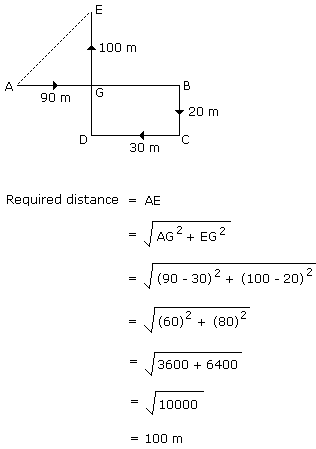
Directions to Solve Each of the following questions is based on the following information:- Six flats on a floor in two rows facing North and South are allotted to P, Q, R, S, T and U.
- Q gets a North facing flat and is not next to S.
- S and U get diagonally opposite flats.
- R next to U, gets a south facing flat and T gets North facing flat.
Question - Which of the following combination get south facing flats?- a)QTS
- b)UPT
- c)URP
- d)Data is inadequate
Correct answer is option 'C'. Can you explain this answer?
Directions to Solve
Each of the following questions is based on the following information:
Question - - Six flats on a floor in two rows facing North and South are allotted to P, Q, R, S, T and U.
- Q gets a North facing flat and is not next to S.
- S and U get diagonally opposite flats.
- R next to U, gets a south facing flat and T gets North facing flat.
Which of the following combination get south facing flats?
a)
QTS
b)
UPT
c)
URP
d)
Data is inadequate

|
Arnav Rane answered |

Hence URP flat combination get south facing flats.
Sundar runs 20 m towards East and turns to right and runs 10 m. Then he turns to the right and runs 9 m. Again he turns to right and runs 5 m. After this he turns to left and runs 12 m and finally he turns to right and 6 m. Now to which direction is Sundar facing?- a)East
- b)West
- c)North
- d)South
Correct answer is option 'C'. Can you explain this answer?
Sundar runs 20 m towards East and turns to right and runs 10 m. Then he turns to the right and runs 9 m. Again he turns to right and runs 5 m. After this he turns to left and runs 12 m and finally he turns to right and 6 m. Now to which direction is Sundar facing?
a)
East
b)
West
c)
North
d)
South

|
Sravya Deshpande answered |
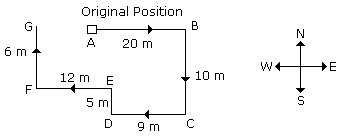
Therefore, it is clear that Sundar will face towards North.
Rasik walked 20 m towards north. Then he turned right and walks 30 m. Then he turns right and walks 35 m. Then he turns left and walks 15 m. Finally he turns left and walks 15 m. In which direction and how many metres is he from the starting position?- a)15 m West
- b)30 m East
- c)30 m West
- d)45 m East
Correct answer is option 'D'. Can you explain this answer?
Rasik walked 20 m towards north. Then he turned right and walks 30 m. Then he turns right and walks 35 m. Then he turns left and walks 15 m. Finally he turns left and walks 15 m. In which direction and how many metres is he from the starting position?
a)
15 m West
b)
30 m East
c)
30 m West
d)
45 m East

|
Debolina Tiwari answered |
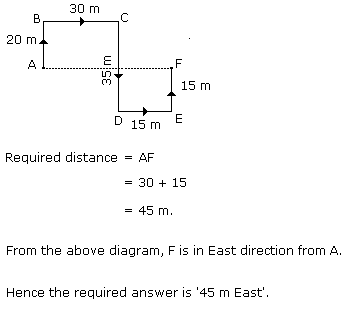
Sachin walks 20 km towards North. He turns left and walks 40 km. He again turns left and walks 20 km. Finally he moves 20 km after turning to the left. How far is he from his starting position?- a)20 km.
- b)30 km.
- c)50 km.
- d)60 km.
Correct answer is option 'A'. Can you explain this answer?
Sachin walks 20 km towards North. He turns left and walks 40 km. He again turns left and walks 20 km. Finally he moves 20 km after turning to the left. How far is he from his starting position?
a)
20 km.
b)
30 km.
c)
50 km.
d)
60 km.

|
Arnav Choudhury answered |
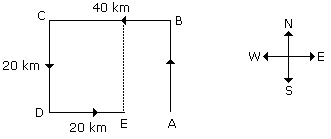
Required distance = 40 - 20 = 20 km.
One morning after sunrise Nivedita and Niharika were talking to each other face to face at Dalphin crossing. If Niharika's shadow was exactly to the right of Nivedita, Which direction Niharika was facing?- a)North
- b)South
- c)East
- d)Data is inadequate
Correct answer is option 'A'. Can you explain this answer?
One morning after sunrise Nivedita and Niharika were talking to each other face to face at Dalphin crossing. If Niharika's shadow was exactly to the right of Nivedita, Which direction Niharika was facing?
a)
North
b)
South
c)
East
d)
Data is inadequate

|
Geetika Sharma answered |

In the morning sun rises in the East. Hence then any shadow falls in the West. Since Nikharia's shadow was exactly to the right of Nivedita. Hence Nikharia is facing towards North.
Some boys are sitting in three rows all facing North such that A is in the middle row. P is just to the right of A but in the same row. Q is just behind of P while R is in the North of A. In which direction of R is Q?- a)South
- b)South-West
- c)North-East
- d)South-East
Correct answer is option 'D'. Can you explain this answer?
Some boys are sitting in three rows all facing North such that A is in the middle row. P is just to the right of A but in the same row. Q is just behind of P while R is in the North of A. In which direction of R is Q?
a)
South
b)
South-West
c)
North-East
d)
South-East

|
Pritam Saha answered |
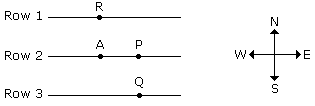
Q is in South-East of R.
From his house, Lokesh went 15 km to the North. Then he turned west and covered 10 km. Then he turned south and covered 5 km. Finally turning to the east, he covered 10 km. In which direction is he from his house?- a)East
- b)West
- c)North
- d)South
Correct answer is option 'C'. Can you explain this answer?
From his house, Lokesh went 15 km to the North. Then he turned west and covered 10 km. Then he turned south and covered 5 km. Finally turning to the east, he covered 10 km. In which direction is he from his house?
a)
East
b)
West
c)
North
d)
South

|
Sanaya Sharma answered |
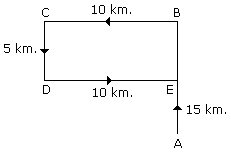
Therefore, it is clear that he is in the North from his house.
K is 40 m South-West of L. If M is 40 m South-East of L, then M is in which direction of K?- a)East
- b)West
- c)North-East
- d)South
Correct answer is option 'A'. Can you explain this answer?
K is 40 m South-West of L. If M is 40 m South-East of L, then M is in which direction of K?
a)
East
b)
West
c)
North-East
d)
South

|
Juhi Dasgupta answered |
K is 40 m South-West of L. If M is 40 m South-East of L, then M is in which direction of K?
To determine the direction of M from K, we need to analyze the given information about their respective positions relative to L. Let's break down the problem step by step:
1. Position of K:
- K is 40 m South-West of L.
2. Position of M:
- M is 40 m South-East of L.
Now, let's analyze the directions:
1. South-West:
- South-West is a combination of two directions: South and West.
- South is a downward direction.
- West is a leftward direction.
2. South-East:
- South-East is a combination of two directions: South and East.
- South is a downward direction.
- East is a rightward direction.
From the given information, we can conclude the following:
1. K is located South-West of L, meaning K is positioned downward and towards the left of L.
2. M is located South-East of L, meaning M is positioned downward and towards the right of L.
Now, let's determine the direction of M from K:
1. M is positioned downward and towards the right of L.
2. K is positioned downward and towards the left of L.
Thus, M is positioned in the East direction of K.
Therefore, the correct answer is option A) East.
To determine the direction of M from K, we need to analyze the given information about their respective positions relative to L. Let's break down the problem step by step:
1. Position of K:
- K is 40 m South-West of L.
2. Position of M:
- M is 40 m South-East of L.
Now, let's analyze the directions:
1. South-West:
- South-West is a combination of two directions: South and West.
- South is a downward direction.
- West is a leftward direction.
2. South-East:
- South-East is a combination of two directions: South and East.
- South is a downward direction.
- East is a rightward direction.
From the given information, we can conclude the following:
1. K is located South-West of L, meaning K is positioned downward and towards the left of L.
2. M is located South-East of L, meaning M is positioned downward and towards the right of L.
Now, let's determine the direction of M from K:
1. M is positioned downward and towards the right of L.
2. K is positioned downward and towards the left of L.
Thus, M is positioned in the East direction of K.
Therefore, the correct answer is option A) East.
One evening before sunset Rekha and Hema were talking to each other face to face. If Hema's shadow was exactly to the right of Hema, which direction was Rekha facing?- a)North
- b)South
- c)East
- d)Data is inadequate
Correct answer is option 'B'. Can you explain this answer?
One evening before sunset Rekha and Hema were talking to each other face to face. If Hema's shadow was exactly to the right of Hema, which direction was Rekha facing?
a)
North
b)
South
c)
East
d)
Data is inadequate

|
Pallavi Mishra answered |
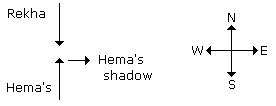
In the evening sun sets in West. Hence then any shadow falls in the East. Since Hema's shadow was to the right of Hema. Hence Rekha was facing towards South.
Directions to Solve Each of the following questions is based on the following information:- Six flats on a floor in two rows facing North and South are allotted to P, Q, R, S, T and U.
- Q gets a North facing flat and is not next to S.
- S and U get diagonally opposite flats.
- R next to U, gets a south facing flat and T gets North facing flat.
Question - Whose flat is between Q and S?- a)T
- b)U
- c)R
- d)P
Correct answer is option 'A'. Can you explain this answer?
Directions to Solve
Each of the following questions is based on the following information:
Question - - Six flats on a floor in two rows facing North and South are allotted to P, Q, R, S, T and U.
- Q gets a North facing flat and is not next to S.
- S and U get diagonally opposite flats.
- R next to U, gets a south facing flat and T gets North facing flat.
Whose flat is between Q and S?
a)
T
b)
U
c)
R
d)
P
|
|
Aarav Sharma answered |
Question Analysis:
The question provides us with the following information:
- There are six flats on a floor in two rows facing North and South.
- Q gets a North facing flat and is not next to S.
- S and U get diagonally opposite flats.
- R, next to U, gets a south facing flat.
- T gets a North facing flat.
We need to determine whose flat is between Q and S.
Solution:
To solve this question, we need to analyze the given information and make deductions based on it.
Given Information:
- Q gets a North facing flat.
- S and U get diagonally opposite flats.
- R, next to U, gets a south facing flat.
- T gets a North facing flat.
Step 1: Identifying the Possible Positions of Q and S
Since Q gets a North facing flat and is not next to S, we can determine the possible positions for Q and S as follows:
1. Q can be in the first row facing North, and S can be in the second row facing South.
2. Q can be in the second row facing North, and S can be in the first row facing South.
Step 2: Analyzing the Positions of R and U
- S and U get diagonally opposite flats. This means that if S is in the first row, U will be in the second row, and vice versa.
- R, next to U, gets a south facing flat.
Based on this information, we can determine the positions of R and U as follows:
1. If Q is in the first row and S is in the second row, then R will be in the second row next to U.
2. If Q is in the second row and S is in the first row, then R will be in the first row next to U.
Step 3: Analyzing the Positions of T and P
- T gets a North facing flat.
- T cannot be next to Q or S.
Based on this information, we can determine the positions of T and P as follows:
1. If Q is in the first row and S is in the second row, then T will be in the first row, and P will be in the second row.
2. If Q is in the second row and S is in the first row, then T will be in the second row, and P will be in the first row.
Answer: T
Based on the above analysis, we can conclude that T's flat is between Q and S.
Therefore, the correct answer is option 'A' - T.
The question provides us with the following information:
- There are six flats on a floor in two rows facing North and South.
- Q gets a North facing flat and is not next to S.
- S and U get diagonally opposite flats.
- R, next to U, gets a south facing flat.
- T gets a North facing flat.
We need to determine whose flat is between Q and S.
Solution:
To solve this question, we need to analyze the given information and make deductions based on it.
Given Information:
- Q gets a North facing flat.
- S and U get diagonally opposite flats.
- R, next to U, gets a south facing flat.
- T gets a North facing flat.
Step 1: Identifying the Possible Positions of Q and S
Since Q gets a North facing flat and is not next to S, we can determine the possible positions for Q and S as follows:
1. Q can be in the first row facing North, and S can be in the second row facing South.
2. Q can be in the second row facing North, and S can be in the first row facing South.
Step 2: Analyzing the Positions of R and U
- S and U get diagonally opposite flats. This means that if S is in the first row, U will be in the second row, and vice versa.
- R, next to U, gets a south facing flat.
Based on this information, we can determine the positions of R and U as follows:
1. If Q is in the first row and S is in the second row, then R will be in the second row next to U.
2. If Q is in the second row and S is in the first row, then R will be in the first row next to U.
Step 3: Analyzing the Positions of T and P
- T gets a North facing flat.
- T cannot be next to Q or S.
Based on this information, we can determine the positions of T and P as follows:
1. If Q is in the first row and S is in the second row, then T will be in the first row, and P will be in the second row.
2. If Q is in the second row and S is in the first row, then T will be in the second row, and P will be in the first row.
Answer: T
Based on the above analysis, we can conclude that T's flat is between Q and S.
Therefore, the correct answer is option 'A' - T.
A man walks 5 km toward south and then turns to the right. After walking 3 km he turns to the left and walks 5 km. Now in which direction is he from the starting place?- a)West
- b)South
- c)North-East
- d)South-West
Correct answer is option 'D'. Can you explain this answer?
A man walks 5 km toward south and then turns to the right. After walking 3 km he turns to the left and walks 5 km. Now in which direction is he from the starting place?
a)
West
b)
South
c)
North-East
d)
South-West

|
Pritam Saha answered |
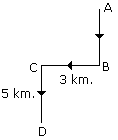
Hence required direction is South-West.
Umesh directly went from P, to Q which is 9 feet distant. Then he turns to the right and walked 4 feet. After this he turned to the right and walked a distance which is equal from P to Q. Finally he turned to the right and walked 3 feet. How far is he now from P?- a)6 feet
- b)5 feet
- c)1 feet
- d)0 feet
Correct answer is option 'C'. Can you explain this answer?
Umesh directly went from P, to Q which is 9 feet distant. Then he turns to the right and walked 4 feet. After this he turned to the right and walked a distance which is equal from P to Q. Finally he turned to the right and walked 3 feet. How far is he now from P?
a)
6 feet
b)
5 feet
c)
1 feet
d)
0 feet

|
Asha Basak answered |
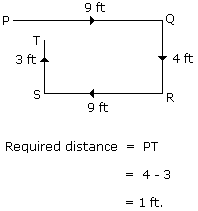
If South-East becomes North, North-East becomes West and so on. What will West become?- a)North-East
- b)North-West
- c)South-East
- d)South-West
Correct answer is option 'C'. Can you explain this answer?
If South-East becomes North, North-East becomes West and so on. What will West become?
a)
North-East
b)
North-West
c)
South-East
d)
South-West

|
Aravind Pillai answered |
Solution:
To solve this question, we need to understand the given transformation rule that South-East becomes North, North-East becomes West, and so on. Based on this rule, we can find out what West will become.
Transformation Rule:
- South-East → North
- North-East → West
- West → ?
- North → South-East
- East → South-West
- South → North-West
Finding the Transformation for West:
- According to the given rule, North-East becomes West.
- Therefore, West will become the opposite of North-East, which is South-West.
- Hence, the correct answer is option C, i.e., South-East.
Final Answer:
- West will become South-East.
To solve this question, we need to understand the given transformation rule that South-East becomes North, North-East becomes West, and so on. Based on this rule, we can find out what West will become.
Transformation Rule:
- South-East → North
- North-East → West
- West → ?
- North → South-East
- East → South-West
- South → North-West
Finding the Transformation for West:
- According to the given rule, North-East becomes West.
- Therefore, West will become the opposite of North-East, which is South-West.
- Hence, the correct answer is option C, i.e., South-East.
Final Answer:
- West will become South-East.
Directions to Solve Each of the following questions is based on the following information:- Six flats on a floor in two rows facing North and South are allotted to P, Q, R, S, T and U.
- Q gets a North facing flat and is not next to S.
- S and U get diagonally opposite flats.
- R next to U, gets a south facing flat and T gets North facing flat.
Question - The flats of which of the other pair than SU, is diagonally opposite to each other?- a)QP
- b)QR
- c)PT
- d)TS
Correct answer is option 'A'. Can you explain this answer?
Directions to Solve
Each of the following questions is based on the following information:
Question - - Six flats on a floor in two rows facing North and South are allotted to P, Q, R, S, T and U.
- Q gets a North facing flat and is not next to S.
- S and U get diagonally opposite flats.
- R next to U, gets a south facing flat and T gets North facing flat.
The flats of which of the other pair than SU, is diagonally opposite to each other?
a)
QP
b)
QR
c)
PT
d)
TS

|
Arnav Choudhury answered |

Hence QP is diagonally opposite to each other.
Ravi left home and cycled 10 km towards South, then turned right and cycled 5 km and then again turned right and cycled 10 km. After this he turned left and cycled 10 km. How many kilometers will he have to cycle to reach his home straight?- a)10 km
- b)15 km
- c)20 km
- d)25 km
Correct answer is option 'B'. Can you explain this answer?
Ravi left home and cycled 10 km towards South, then turned right and cycled 5 km and then again turned right and cycled 10 km. After this he turned left and cycled 10 km. How many kilometers will he have to cycle to reach his home straight?
a)
10 km
b)
15 km
c)
20 km
d)
25 km

|
Ankit Ghosh answered |
Understanding the problem
Ravi initially cycled 10 km towards the South, then turned right and cycled 5 km, followed by another right turn and cycling 10 km. Finally, he turned left and cycled 10 km. We need to determine how many kilometers he will have to cycle to reach his home straight.
Calculating the total distance traveled
- South: 10 km
- Right: 5 km
- Right: 10 km
- Left: 10 km
Finding the direction to the home
To find the direction Ravi needs to cycle to reach his home straight, we need to determine the remaining distance and direction from his current position.
- Ravi has cycled 10 km towards the South, 5 km to the right, and 10 km to the right again. This means he has covered 10 + 5 + 10 = 25 km in total.
- Since he still needs to cycle towards his home, which is in the opposite direction of his current position, he would have to cycle 15 km to reach his home straight.
Therefore, the correct answer is option B) 15 km.
Directions to Solve Dev, Kumar, Nilesh, Ankur and Pintu are standing facing to the North in a playground such as given below:- Kumar is at 40 m to the right of Ankur.
- Dev is are 60 m in the south of Kumar.
- Nilesh is at a distance of 25 m in the west of Ankur.
- Pintu is at a distance of 90 m in the North of Dev.
Question - If a boy starting from Nilesh, met to Ankur and then to Kumar and after this he to Dev and then to Pintu and whole the time he walked in a straight line, then how much total distance did he cover?- a)215 m
- b)155 m
- c)245 m
- d)185 m
Correct answer is option 'A'. Can you explain this answer?
Directions to Solve
Dev, Kumar, Nilesh, Ankur and Pintu are standing facing to the North in a playground such as given below:
Question - - Kumar is at 40 m to the right of Ankur.
- Dev is are 60 m in the south of Kumar.
- Nilesh is at a distance of 25 m in the west of Ankur.
- Pintu is at a distance of 90 m in the North of Dev.
If a boy starting from Nilesh, met to Ankur and then to Kumar and after this he to Dev and then to Pintu and whole the time he walked in a straight line, then how much total distance did he cover?
a)
215 m
b)
155 m
c)
245 m
d)
185 m

|
Sameer Shah answered |
Required distance = 25 m + 40 m + 60 m + 90 m
Required distance = 215 m
Amit started walking positioning his back towards the sun. After some time, he turned left, then turned right and towards the left again. In which direction is he going now? Given amit starts walking in the morning
- a)North or South
- b)East or West
- c)North or West
- d)South or West
Correct answer is option 'A'. Can you explain this answer?
Amit started walking positioning his back towards the sun. After some time, he turned left, then turned right and towards the left again. In which direction is he going now? Given amit starts walking in the morning
a)
North or South
b)
East or West
c)
North or West
d)
South or West

|
Sameer Shah answered |
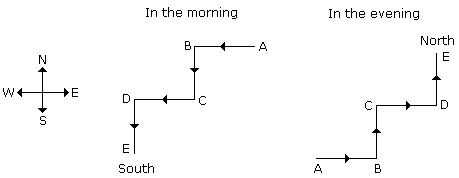
If he starts walking the morning then finally he will face towards South and if he starts in the evening then finally he will face towards North.
X started to walk straight towards south. After walking 5 m he turned to the left and walked 3 m. After this he turned to the right and walked 5 m Now to which direction X is facing?- a)North-East
- b)South
- c)North
- d)South-West
Correct answer is option 'B'. Can you explain this answer?
X started to walk straight towards south. After walking 5 m he turned to the left and walked 3 m. After this he turned to the right and walked 5 m Now to which direction X is facing?
a)
North-East
b)
South
c)
North
d)
South-West

|
Anjali Nair answered |
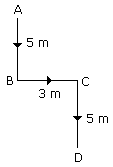
Hence X will face in the end towards South.
Chapter doubts & questions for Chapter 10: Direction Tests - Quantitative Aptitude for CA Foundation 2025 is part of CA Foundation exam preparation. The chapters have been prepared according to the CA Foundation exam syllabus. The Chapter doubts & questions, notes, tests & MCQs are made for CA Foundation 2025 Exam. Find important definitions, questions, notes, meanings, examples, exercises, MCQs and online tests here.
Chapter doubts & questions of Chapter 10: Direction Tests - Quantitative Aptitude for CA Foundation in English & Hindi are available as part of CA Foundation exam.
Download more important topics, notes, lectures and mock test series for CA Foundation Exam by signing up for free.
Quantitative Aptitude for CA Foundation
101 videos|209 docs|89 tests
|

Contact Support
Our team is online on weekdays between 10 AM - 7 PM
Typical reply within 3 hours
|
Free Exam Preparation
at your Fingertips!
Access Free Study Material - Test Series, Structured Courses, Free Videos & Study Notes and Prepare for Your Exam With Ease

 Join the 10M+ students on EduRev
Join the 10M+ students on EduRev
|

|
Create your account for free
OR
Forgot Password
OR
Signup to see your scores
go up
within 7 days!
within 7 days!
Takes less than 10 seconds to signup

